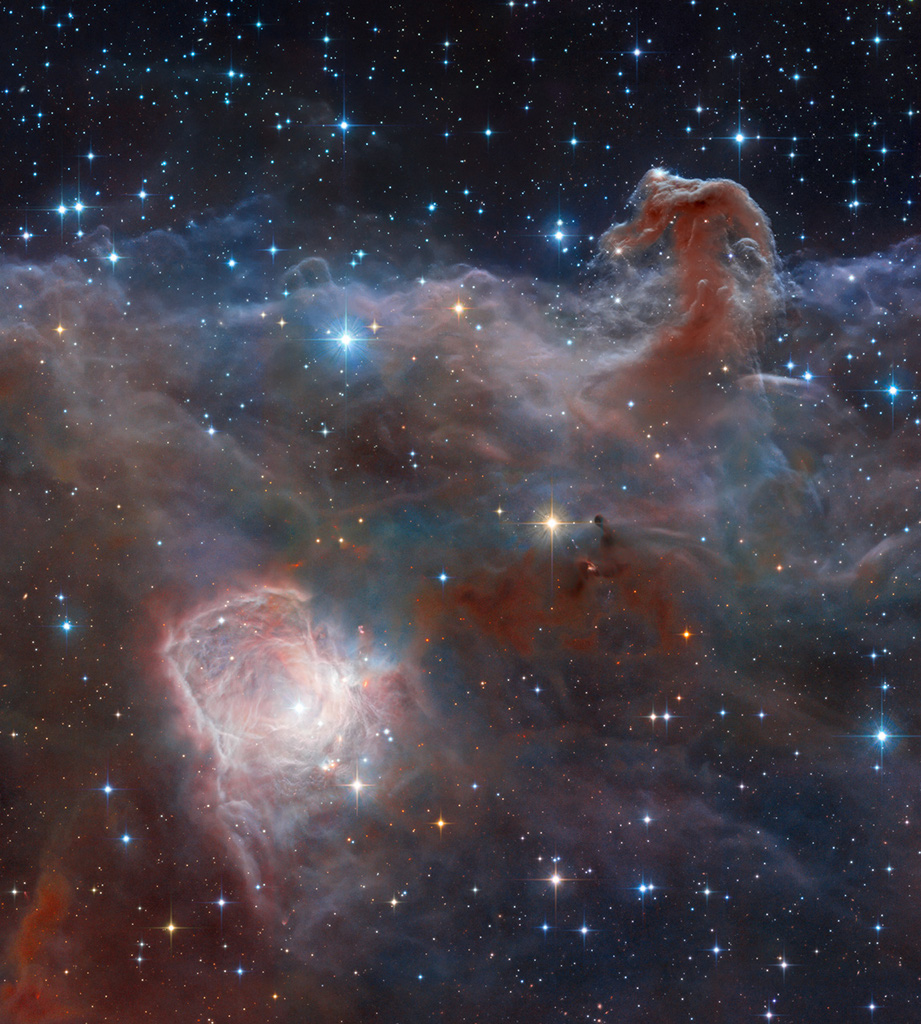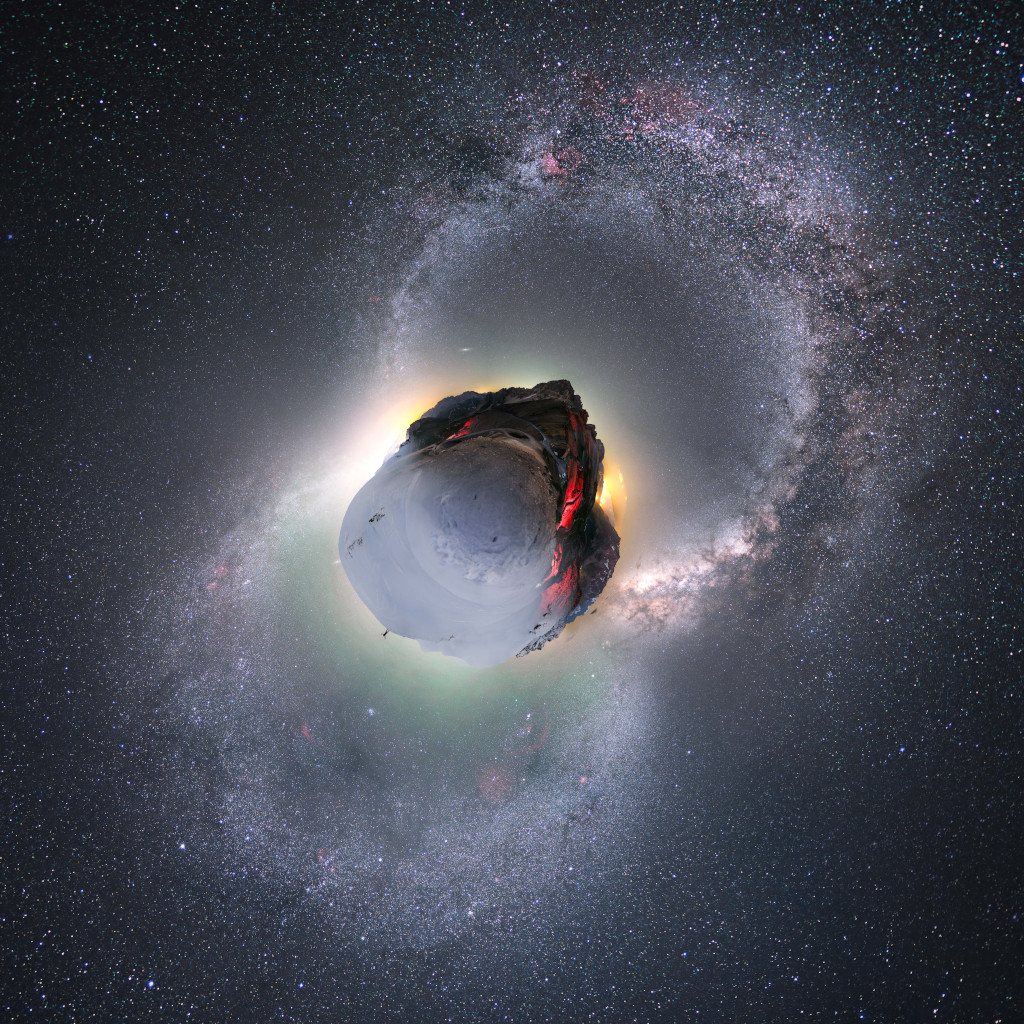
|
| Title: NASA pics | |
| Grapevine50sRoost > ~GENERAL~ > GENERAL DISCUSSION | Go to subcategory: |
| Author | Content |
|
zxxlyzq
|
|
|
Date Posted:09/03/2018 12:10 PMCopy HTML Composition and Processing: Robert Gendler Image Data: ESO, VISTA, HLA, Hubble Heritage Team (STScI/AURA) Explanation: Combined image data from the massive, ground-based VISTA telescope and the Hubble Space Telescope was used to create this wide perspective of the interstellar landscape surrounding the famous Horsehead Nebula. Captured at near-infrared wavelengths, the region's dusty molecular cloud sprawls across the scene that covers an angle about two-thirds the size of the Full Moon on the sky. Left to right the frame spans just over 10 light-years at the Horsehead's estimated distance of 1,600 light-years. Also known as Barnard 33, the still recognizable Horsehead Nebula stands at the upper right, the near-infrared glow of a dusty pillar topped with newborn stars. Below and left, the bright reflection nebula NGC 2023 is itself the illuminated environs of a hot young star. Obscuring clouds below the base of the Horsehead and on the outskirts of NGC 2023 show the tell-tale far red emission of energetic jets, known as Herbig-Haro objects, also associated with newborn stars. |
|
|
Rockymz
|
Share to:





 #61
#61
|
|
Re:NASA pics Date Posted:28/08/2025 9:04 AMCopy HTML Image Credit & Copyright: Robert Eder Explanation: This well-composed telescopic field of view covers over a Full Moon on the sky toward the high-flying constellation Pegasus. Of course the brighter stars show diffraction spikes, the commonly seen effect of internal supports in reflecting telescopes, and lie well within our own Milky Way galaxy. The faint but pervasive clouds of interstellar dust ride above the galactic plane and dimly reflect the Milky Way's starlight. Known as galactic cirrus or integrated flux nebulae they are associated with the Milky Way's molecular clouds. In fact, the diffuse cloud cataloged as MBM 54, less than a thousand light-years distant, fills the scene. The galaxy seemingly tangled in the dusty cloud is the striking spiral galaxy NGC 7497. It's some 60 million light-years away, though. Seen almost edge-on near the center of the field, NGC 7497's own spiral arms and dust lanes echo the colors of stars and dust in our own Milky Way. |
|
|
Megan57
|
Share to:





 #62
#62
|
|
Re:NASA pics Date Posted:28/08/2025 5:38 AMCopy HTML
|
|
|
Rockymz
|
Share to:





 #63
#63
|
|
Re:NASA pics Date Posted:27/08/2025 7:17 AMCopy HTML Image Credit: ESO, VLT, SPHERE; Processing & Copyright: ESO, Richelle van Capelleveen (Leiden Obs.) et al.; Text: Ogetay Kayali (MTU) Explanation: That yellow spot -- what is it? It's a young planet outside our Solar System. The featured image from the Very Large Telescope in Chile surprisingly captures a distant scene much like our own Solar System's birth, some 4.5 billion years ago. Although we can't look into the past and see Earth's formation directly, telescopes let us watch similar processes unfolding around distant stars. At the center of this frame lies a young Sun-like star, hidden behind a coronagraph that blocks its bright glare. Surrounding the star is a bright, dusty protoplanetary disk -- the raw material of planets. Gaps and concentric rings mark where a newborn world is gathering gas and dust under its gravity, clearing the way as it orbits the star. Although astronomers have imaged disk-embedded planets before, this is the first-ever observation of an exoplanet actively carving a gap within a disk -- the earliest direct glimpse of planetary sculpting in action. |
|
|
Megan57
|
Share to:





 #64
#64
|
|
Re:NASA pics Date Posted:27/08/2025 5:53 AMCopy HTML Amazing Rocky |
|
|
Rockymz
|
Share to:





 #65
#65
|
|
Re:NASA pics Date Posted:26/08/2025 8:24 AMCopy HTML Image Credit & Copyright: Camille Niel Explanation: Winter and summer appear to come on a single night to this stunning little planet. It's planet Earth of course. The digitally mapped, nadir centered panorama covers 360x180 degrees and is composed of frames recorded during January and July from the Col du Galibier in the French Alps. Stars and nebulae of the northern winter (bottom) and summer Milky Way form the complete arcs traversing the rugged, curved horizon. Cars driving along on the road during a summer night illuminate the 2,642 meter high mountain pass, but snow makes access difficult during winter months except by serious ski touring. Cycling fans will recognize the Col du Galibier as one of the most famous climbs in planet Earth's Tour de Franc |
|
|
Megan57
|
Share to:





 #66
#66
|
|
Re:NASA pics Date Posted:26/08/2025 6:00 AMCopy HTML
|
|
|
Rockymz
|
Share to:





 #67
#67
|
|
Re:NASA pics Date Posted:25/08/2025 8:18 AMCopy HTML Image Credit & Copyright: Yousif Alqasimi & Essa Al Jasmi Explanation: Sometimes even the sky surprises you. To see more stars and faint nebulosity in the Pleiades star cluster (M45), long exposures are made. Many times, less interesting items appear on the exposures that were not intended -- but later edited out. These include stuck pixels, cosmic ray hits, frames with bright clouds or Earth's Moon, airplane trails, lens flares, faint satellite trails, and even insect trails. Sometimes, though, something really interesting is caught by chance. That was just the case a few weeks ago in al-Ula, Saudi Arabia when a bright meteor streaked across during an hour-long exposure of the Pleiades. Along with the famous bright blue stars, less famous and less bright blue stars, and blue-reflecting dust surrounding the star cluster, the fast rock fragment created a distinctive green glow, likely due to vaporized metals. |
|
|
Megan57
|
Share to:





 #68
#68
|
|
Re:NASA pics Date Posted:25/08/2025 6:33 AMCopy HTML
|
|
|
Rockymz
|
Share to:





 #69
#69
|
|
Re:NASA pics Date Posted:24/08/2025 11:17 AMCopy HTML Image Credit: NASA: X-ray: Chandra (CXC), Optical: Hubble (STScI), Infrared: Spitzer (JPL-Caltech) Explanation: At the core of the Crab Nebula lies a city-sized, magnetized neutron star spinning 30 times a second. Known as the Crab Pulsar, it is the bright spot in the center of the gaseous swirl at the nebula's core. About twelve light-years across, the spectacular picture frames the glowing gas, cavities and swirling filaments near the Crab Nebula's center. The featured picture combines visible light from the Hubble Space Telescope in purple, X-ray light from the Chandra X-ray Observatory in blue, and infrared light from the Spitzer Space Telescope in red. Like a cosmic dynamo, the Crab pulsar powers the emission from the nebula, driving a shock wave through surrounding material and accelerating the spiraling electrons. With more mass than the Sun and the density of an atomic nucleus,the spinning pulsar is the collapsed core of a massive star that exploded. The outer parts of the Crab Nebula are the expanding remnants of the star's component gases. The supernova explosion was witnessed on planet Earth in the year 1054. |
|
|
Megan57
|
Share to:





 #70
#70
|
|
Re:NASA pics Date Posted:24/08/2025 7:03 AMCopy HTML
|
|
|
Rockymz
|
Share to:





 #71
#71
|
|
Re:NASA pics Date Posted:23/08/2025 9:11 AMCopy HTML Image Credit & Copyright: Marco Bellelli Explanation: How big is planet Earth's Moon? Compared to other moons of the Solar System, it's number 5 on the largest to smallest ranked list, following Jupiter's moon Ganymede, Saturn's moon Titan, and Jovian moons Callisto and Io. Continuing the list, the Moon comes before Jupiter's Europa and Neptune's Triton. It's also larger than dwarf planets Pluto and Eris. With a diameter of 3,475 kilometers the Moon is about 1/4 the size of Earth though, and that does make it the largest moon when compared to the size of its parent Solar System planet. Of course in this serene, twilight sea and skyscape, August's rising Full Moon still appears small enough to be caught in the nets of an ancient fishing rig. The telephoto snapshot was taken along the Italian Costa dei Trabocchi, on the Adriatic Sea. |
|
|
Megan57
|
Share to:





 #72
#72
|
|
Re:NASA pics Date Posted:23/08/2025 6:59 AMCopy HTML
|
|
|
Rockymz
|
Share to:





 #73
#73
|
|
Re:NASA pics Date Posted:22/08/2025 7:58 AMCopy HTML Image Credit & Copyright: Kent Biggs Explanation: This colorful telescopic view towards the musical northern constellation Lyra reveals the faint outer halos and brighter central ring-shaped region of M57, popularly known as the Ring Nebula. To modern astronomers M57 is a well-known planetary nebula. With a central ring about one light-year across, M57 is definitely not a planet though, but the gaseous shroud of one of the Milky Way's dying sun-like stars. Roughly the same apparent size as M57, the fainter and more often overlooked barred spiral galaxy at the left is IC 1296. In fact, over 100 years ago IC 1296 would have been known as a spiral nebula. By chance the pair are in the same field of view, and while they appear to have similar sizes they are actually very far apart. At a distance of a mere 2,000 light-years M57 is well within our own Milky Way galaxy. Extragalactic IC 1296 (aka PGC62532) is more like 200,000,000 light-years distant. That's about 100,000 times farther away than M57 but since they appear roughly similar in size, former spiral nebula IC 1296 must also be about 100,000 times larger than planetary nebula M57. Look closely at the sharp 21st century astroimage to spot even more distant background galaxies scattered through the frame. |
|
|
Megan57
|
Share to:





 #74
#74
|
|
Re:NASA pics Date Posted:22/08/2025 6:07 AMCopy HTML
|
|
|
Rockymz
|
Share to:





 #75
#75
|
|
Re:NASA pics Date Posted:21/08/2025 9:22 AMCopy HTML Image Credit & Copyright: Klaus Pillwatsch Explanation: In this predawn skyscape recorded during the early morning hours of August 13, mostly Perseid meteors are raining down on planet Earth. You can easily identify the Perseid meteor streaks. They're the ones with trails that seem to converge on the annual meteor shower's radiant, a spot in the heroic constellation Perseus, located off the top of the frame. That's the direction in Earth's sky that looks along the orbit of this meteor shower's parent, periodic Comet Swift-Tuttle. Of course the scene is a composite, a combination of about 500 digital exposures to capture meteors registered with a single base frame exposure. But all exposures were taken during a period of around 2.5 hours from a wind farm near Mönchhof, Burgenland, Austria. Red lights on the individual wind turbine towers dot the foreground. In their spectacular close conjunction, bright planets Jupiter and Venus are poised above the eastern horizon. |
|
|
Megan57
|
Share to:





 #76
#76
|
|
Re:NASA pics Date Posted:21/08/2025 6:06 AMCopy HTML
|
|
|
Rockymz
|
Share to:





 #77
#77
|
|
Re:NASA pics Date Posted:20/08/2025 7:40 AMCopy HTML Image Credit & Copyright: Josh Dury Explanation: What are those curved arcs in the sky? Meteors -- specifically, meteors from this year's Perseid meteor shower. Over the past few weeks, after the sky darkened, many images of Perseid meteors were captured separately and merged into a single frame, taken earlier. Although the meteors all traveled on straight paths, these paths appear slightly curved by the wide-angle lens of the capturing camera. The meteor streaks can all be traced back to a single point on the sky called the radiant, here just off the top of the frame in the constellation of Perseus. The same camera took a deep image of the background sky that brought up the central band of our Milky Way galaxy running nearly vertically through the featured image's center. The limestone arch in the foreground in Dorset, England is known as Durdle Door, a name thought to survive from a thousand years ago. |
|
|
Megan57
|
Share to:





 #78
#78
|
|
Re:NASA pics Date Posted:20/08/2025 6:07 AMCopy HTML Amazing Rocky. I thought it looked like a frog |
|
|
Rockymz
|
Share to:





 #79
#79
|
|
Re:NASA pics Date Posted:19/08/2025 7:37 AMCopy HTML Image Credit & Copyright: Adam Block Explanation: Over 500,000 light years across, NGC 6872 (bottom left) is a truly enormous barred spiral galaxy. At least 5 times the size of our own large Milky Way, NGC 6872 is the largest known spiral galaxy. About 200 million light-years distant toward the southern constellation Pavo, the Peacock, the appearance of this giant galaxy's stretched out spiral arms suggest the wings of a giant bird. So its popular moniker is the Condor galaxy. Lined with massive young, bluish star clusters and star-forming regions, the extended and distorted spiral arms are due to NGC 6872's past gravitational interactions with the nearby smaller galaxy IC 4970, visible here below the giant spiral galaxy's core. Other members of the southern Pavo galaxy group are scattered through this magnificent galaxy group portrait, with the dominant giant elliptical galaxy, NGC 6876, above and right of the soaring Condor galaxy. |
|
|
Megan57
|
Share to:





 #80
#80
|
|
Re:NASA pics Date Posted:19/08/2025 5:42 AMCopy HTML
|
|
|
Rockymz
|
Share to:





 #81
#81
|
|
Re:NASA pics Date Posted:18/08/2025 8:58 AMCopy HTML Image Credit: NASA, ESA, Hubble; Processing: L. Galbany, S. Jha, K. Noll, A. Riess Explanation: This galaxy is not only pretty -- it's useful. A gorgeous spiral some 100 million light-years distant, NGC 1309 lies on the banks of the constellation of the River (Eridanus). NGC 1309 spans about 30,000 light-years, making it about one third the size of our larger Milky Way galaxy. Bluish clusters of young stars and dust lanes are seen to trace out NGC 1309's spiral arms as they wind around an older yellowish star population at its core. Not just another pretty face-on spiral galaxy, observations of NGC 1309's two recent supernovas and multiple Cepheid variable stars contribute to the calibration of the expansion of the Universe. Still, after you get over this beautiful galaxy's grand design, check out the array of more distant background galaxies also recorded in this sharp image from the Hubble Space Telescope. |
|
|
Megan57
|
Share to:





 #82
#82
|
|
Re:NASA pics Date Posted:18/08/2025 6:06 AMCopy HTML
|
|
|
Rockymz
|
Share to:





 #83
#83
|
|
Re:NASA pics Date Posted:17/08/2025 7:39 AMCopy HTML Image Credit & Copyright: Witta Priester Explanation: What kind of clouds are these? Although their cause is presently unknown, such unusual atmospheric structures, as menacing as they might seem, do not appear to be harbingers of meteorological doom. Formally recognized as a distinct cloud type only last year, asperitas clouds can be stunning in appearance, unusual in occurrence, and are relatively unstudied. Whereas most low cloud decks are flat bottomed, asperitas clouds appear to have significant vertical structure underneath. Speculation therefore holds that asperitas clouds might be related to lenticular clouds that form near mountains, or mammatus clouds associated with thunderstorms, or perhaps a foehn -- a type of dry downward wind that flows off mountains. Clouds from such a wind called the Canterbury arch stream toward the east coast of New Zealand's South Island. The featured image, taken above Hanmer Springs in Canterbury, New Zealand in 2005, shows great detail partly because sunlight illuminates the undulating clouds from the side. |
|
|
Megan57
|
Share to:





 #84
#84
|
|
Re:NASA pics Date Posted:17/08/2025 6:52 AMCopy HTML
|
|
|
Rockymz
|
Share to:





 #85
#85
|
|
Re:NASA pics Date Posted:16/08/2025 7:31 AMCopy HTML Image Credit & Copyright: Renaud & Olivier Coppe Explanation: The camera battery died about 2am local time on August 12, while shooting in the bright moonlit skies from a garden in Chastre, Brabant Wallon, Belgium, planet Earth. But not before it captured the frames used to compose this cool animated gif of a brilliant Perseid meteor and a lingering visible trail known as a persistent train. The Perseid meteor, a fast moving speck of dust from the tail of large periodic Comet Swift-Tuttle, was heated to incandescence by ram pressure and vaporized as it flashed through the upper atmosphere at 60 kilometers per second. Compared to the brief flash of the meteor, its wraith-like trail really is persistent. A characteristic of bright meteors, a smoke-like persistent train can often be followed for many minutes wafting in the winds at altitudes of 60 to 90 kilometers. |
|
|
Megan57
|
Share to:





 #86
#86
|
|
Re:NASA pics Date Posted:16/08/2025 6:06 AMCopy HTML Amazing Rocky |
|
|
Rockymz
|
Share to:





 #87
#87
|
|
Re:NASA pics Date Posted:15/08/2025 6:54 AMCopy HTML Image Credit & Copyright: Jeff Dai (TWAN) Explanation: In the predawn sky on August 13, two planets were close. And despite the glare of a waning gibbous Moon, bright Jupiter and even brighter Venus were hard to miss. Their brilliant close conjunction is posing above the eastern horizon in this early morning skyscape. The scene was captured in a single exposure from a site near Gansu, China, with light from both planets reflected in the still waters of a local pond. Also seen against the moonlight were flashes from the annual Perseid Meteor Shower, known for its bright, fast meteors. Near the much anticipated peak of activity, the shower meteors briefly combined with the two planets for a celestial spectacle even in moonlit skies. |
|
|
Megan57
|
Share to:





 #88
#88
|
|
Re:NASA pics Date Posted:15/08/2025 5:56 AMCopy HTML
|
|
|
Rockymz
|
Share to:





 #89
#89
|
|
Re:NASA pics Date Posted:14/08/2025 7:20 AMCopy HTML Image Credit & Copyright: R. Jay Gabany Explanation: In 1716, English astronomer Edmond Halley noted, "This is but a little Patch, but it shews itself to the naked Eye, when the Sky is serene and the Moon absent." Of course, M13 is now less modestly recognized as the Great Globular Cluster in Hercules, one of the brightest globular star clusters in the northern sky. Sharp telescopic views like this one reveal the spectacular cluster's hundreds of thousands of stars. At a distance of 25,000 light-years, the cluster stars crowd into a region 150 light-years in diameter. Approaching the cluster core, upwards of 100 stars could be contained in a cube just 3 light-years on a side. For comparison with our neighborhood of the Milky Way, the closest star to the Sun is over 4 light-years away. Early telescopic observers of the great globular cluster also noted a curious convergence of three dark lanes with a spacing of about 120 degrees, seen here just below the cluster center. Known as the propeller in M13, the shape is likely a chance optical effect of the distribution of stars viewed from our perspective against the dense cluster core. |
|
|
Megan57
|
Share to:





 #90
#90
|
|
Re:NASA pics Date Posted:14/08/2025 5:53 AMCopy HTML
|





































